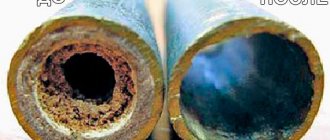Be sure to read the article by our specialist, which talks about which is better - antifreeze or antifreeze.
You can find more detailed information on how to properly dilute antifreeze concentrate in our expert’s material.
Which cleanser should you choose?
Many drivers believe that flushing the VAZ 2107 with ordinary water is the best remedy today. However, this is not the case. The thing is that distilled water contains salts, which during flushing form scale on the walls of the cooling system elements. Needless to say, this kind of deposits has a detrimental effect on the operation of the engine, and, consequently, the entire car as a whole.
As cleaning products, I recommend that you pay attention to the following:
- Aggressive acid additives, which are not sold in pure form, but perfectly remove scale and other deposits from the system
- Alkaline organic matter removers
- A product with a neutral environment, which is still best suited for preventive purposes
We independently change the coolant on a VAZ 2107
Any engine needs proper cooling. And the VAZ 2107 engine is no exception. The cooling in this engine is liquid, it can be either antifreeze or antifreeze. Fluids wear out their service life over time, and the motorist has to change them. Let's figure out how this is done.
Sequence of flushing the system with a special liquid
The sequence of flushing the cooling system with a special composition is practically no different from the sequence of water flushing mentioned above. The only difference is the operating time of the motor. This time must be clarified (it depends on the composition of the selected flushing liquid and must be indicated on the canister with flushing).
Antifreeze
Antifreeze has several advantages. Let's list them:
- protective film. The inorganic salts contained in antifreeze form a thin chemical film on the surface of the cooled parts, which reliably protects the parts from corrosion. Film thickness can reach 0.5 mm;
Of course, antifreeze also has disadvantages. Here they are:
- small resource. Antifreeze quickly becomes unusable. It needs to be changed every 40–60 thousand kilometers;
- effect on aluminum parts. The additives contained in antifreeze negatively affect the aluminum surfaces in the main radiator. In addition, antifreeze can form condensation. These factors significantly reduce the service life of aluminum radiators;
- influence on the water pump; The tendency to form condensation can also have a detrimental effect on the VAZ 2107 , leading to premature wear of its impeller.
Sources:
https://piter-at.ru/raznoe/kak-promyt-sistemu-ohlazhdeniya-dvigatelya-vaz-2107.html https://djago.ru/vaz-2107/kak-promyt-sistemu-ohlazhdeniya-dvigatelya-vaz -2107/ https://autogearspb.ru/zapchasti/kak-promyt-sistemu-ohlazhdeniya-na-vaz-2107.html https://bumper.guru/klassicheskie-modeli-vaz/sistema-ohdazhdeniya/zamena-tosola- vaz-2107.html
Flushing the motor
Using water
As we have already said, the engine cleaning process is quite important. To completely flush the system, you need to perform the following steps:
- First you need to clean the radiator. To do this, drain the used antifreeze from the system and disconnect the pipes from the base to the radiator tank. To flush effectively, you will need a garden hose that must be connected to a faucet. The hose is inserted into the connection pipe of the device, after which the tap is opened. Water must pass through the radiator until it comes out clean.
- Cleaning a car engine is carried out in a similar way. The hose must be inserted into the thermostat outlet channel. Water should be passed through the motor until it comes out crystal clear.
Using special means
- Unscrew the drain plugs and drain the used antifreeze.
- The plugs should be tightened, after which a special flushing agent is poured into the system.
- The engine must be started and run for some time until it warms up completely. When the engine warms up to operating temperature, turn it off.
- Unscrew the drain plug and drain the flushing material. Visually assess its condition - if there is dirt and sediment in it, continue the flushing procedure until the flush comes out of the system clean.
Purpose of coolant on VAZ 2107
It’s easy to guess the purpose of the coolant from its name. It serves to remove excess heat from the engine. It's simple: in any internal combustion engine there are many rubbing parts, which during operation can heat up to a temperature of 300°C. If these parts are not cooled in time, the engine will fail (and the pistons and valves will be the first to suffer from overheating). This is where coolant comes to the rescue. It is supplied to a running engine and circulates there through special channels, taking away excess heat.
Once heated, the coolant goes into the central radiator, which is constantly blown by a powerful fan. The liquid cools in the radiator and is then sent back to the cooling channels of the engine. This is how continuous liquid cooling of the VAZ 2107 .
Antifreeze
Now let's look at the pros and cons of antifreeze. Let's start with the pros:
Flushing and replacing antifreeze VAZ-2107
- long service life. On average, six liters of antifreeze are enough for 150 thousand kilometers;
- temperature selectivity. Thanks to carbonate additives, antifreeze can more actively protect the engine surface that is hottest than others;
And antifreeze has only one disadvantage: high cost. A canister of high-quality antifreeze can cost two or even three times more than a canister of good antifreeze.
Taking into account all the above advantages, the vast majority of VAZ 2107 opt for antifreeze, since saving on coolant has never led to anything good. Almost any antifreeze, both domestic and Western, is suitable for the VAZ 2107 Most often, car owners prefer to use Lukoil G12 RED antifreeze.
Other, less well-known brands of antifreeze are Felix, Aral Extra, Glysantin G48, Zerex G, etc.
Flushing Recommendations
Today in our car stores you can find many different products and liquids for flushing the cooling system. Many car enthusiasts mistakenly believe that the best option is to use distilled water, but this is far from the case. Ordinary liquid contains a large amount of salts, which, as a result of washing, form scale on the internal walls of the system elements.
Special equipment
The range of specialized cleaning products is quite huge - liquids with different compositions and concentrations can be found on sale. However, you need to pay attention to the choice of cleanser, since different products should be used to remove different types of contaminants. In general, such liquids are divided into several types:
- Neutral products contain no aggressive elements. It is better to use such products for preventive purposes, since they are not very effective for flushing directly.
- The composition of acid additives is very aggressive, so they are not sold in their pure form. Usually used by specialists to remove scale from the cooling system.
- Alkaline products have an aggressive composition and are designed to remove organic formations.
- In the case of two-element products containing alkali and acid, flushing allows you to remove almost all types of contaminants from the cooling system.
Experts do not recommend using several types of liquids at the same time because alkali and acid can be neutralized by each other when interacting. Accordingly, this will not bring the desired result. We also do not recommend using too concentrated products, as this may cause the liquid to corrode the rubber and plastic components of the system.
Traditional methods
Cleaning the cooling system with citric acid is an old flushing method that has been used by domestic motorists for decades. If the proportions are correct, then citric acid will allow you to optimally remove scale from the radiator, without negatively affecting rubber and plastic. According to experienced motorists, you will need about 100 grams of citric acid per 1 liter of distillate. But keep in mind that no one is responsible for the effectiveness of the method, so all responsibility falls on you.
Car enthusiasts also practice using regular cleaning serum instead of citric acid. According to those who practice this method regularly, the composition of the serum allows for effective and, importantly, gentle flushing of the car’s cooling system. As in the previous case, the serum will not destroy rubber and plastic elements. According to experts, this procedure should be carried out in two or three short approaches - this will allow the system to be flushed most effectively.
"Coca Cola"
There are different opinions among our car enthusiasts about Coca-Cola. One claims that thanks to aggressive components, such as phosphoric acid, included in the drink, Coca-Cola can effectively remove all dirt and scale from the elements of the car’s cooling system. According to others, such an aggressive drink should be used very carefully, or better not used at all, since sugar, which is in excess in the composition, will only contribute to clogging of the pipes. So if you decide to use the drink, then after it in any case you need to use the distillate again to eliminate sugar residues.
Also, the drink can damage the car due to the presence of gas in it. Since gas tends to expand when interacting with the heat of a car engine, this can cause certain problems. So in case you don't have the right products on hand to clean the system, but you have a nosebleed, you need to do it, get rid of the gas in your drink. Open it and leave it with the cap open for an hour. The longer, the more gases will come out of the bottle.
Coca-Cola for rinsing
About antifreeze and antifreeze
It should be said right away that dividing coolants into antifreeze and antifreeze is accepted only in Russia. To understand why this happened, you need to answer the question: what is coolant anyway?
As a rule, the base for the coolant is ethylene glycol (in rare cases, propylene glycol), to which water and a set of special additives are added to prevent corrosion. Different manufacturers have different sets of additives. And all coolants on the market today are classified according to the technologies for producing these additives. There are three technologies:
- traditional. Additives are made from salts of inorganic acids (silicates, nitrites, amines or phosphates);
- carboxylate. Additives in carboxylate fluids are obtained only from organic carbonates;
- hybrid. In this technology, manufacturers add a small percentage of inorganic salts (most often phosphates or silicates) to organic carbonate additives.
Coolant made using traditional technology is called antifreeze, and liquid made using carboxylate technology is called antifreeze. Let's take a closer look at these liquids.
Flushing the cooling system with water
It should be said right away that it is advisable to use this washing option only when there is no good washing liquid at hand. The fact is that ordinary water contains impurities that form scale. And if the driver still decides to flush the cooling system with water, then the best choice in this situation would be distilled water.











